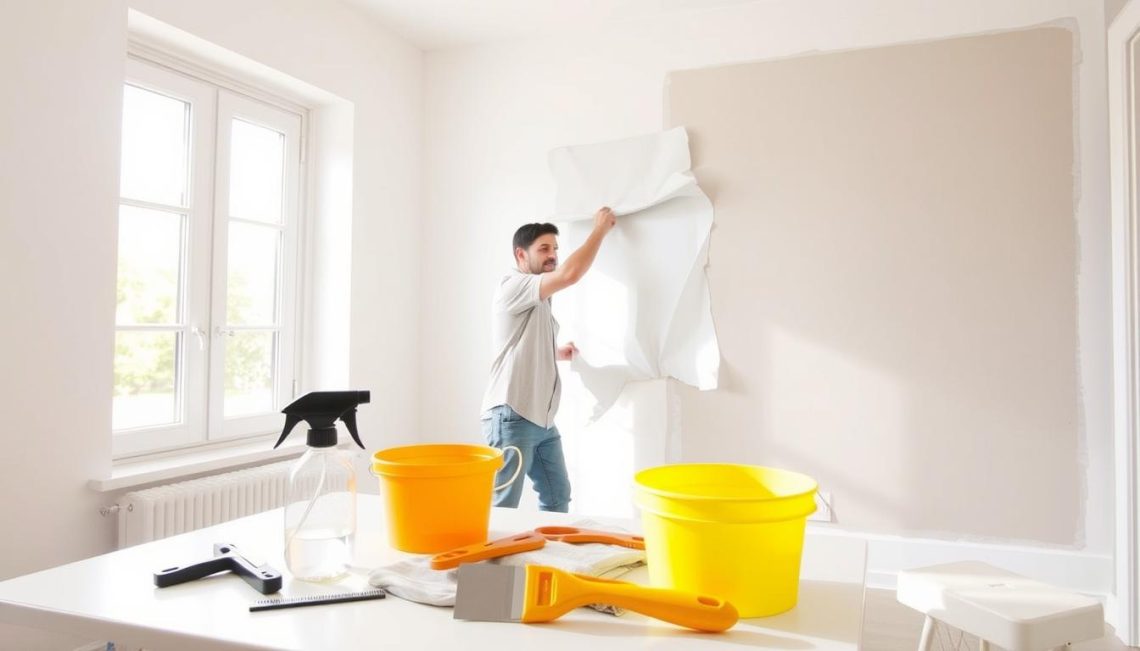Removing wallpaper can be a daunting task, but with the right techniques, it can be done efficiently. We’ve all been there – staring at a wall covered in outdated or damaged wallpaper, wondering how to get rid of it.
Choosing the right wallpaper removal technique is crucial, as it depends on the type of wallpaper and the surface it’s adhered to. In this article, we’ll explore three DIY wallpaper removal methods that have been tried and tested.
By the end of this guide, you’ll be equipped with the knowledge to tackle your wallpaper removal project with confidence, using the most suitable method for your specific needs.
Understanding Wallpaper Removal Challenges
Understanding the challenges of wallpaper removal is crucial for a successful renovation. Removing wallpaper can be a complex process due to the variety of types and the adhesives used.
Common Types of Wallpaper and Their Removal Difficulty
Different types of wallpaper present unique removal challenges. The main types include:
- Paper-backed vinyl: Requires scoring and steaming for removal.
- Non-woven wallpaper: Can be removed more easily as it tears apart.
- Traditional paper: Often requires a chemical stripper or a steamer.
Knowing the type of wallpaper you’re dealing with is the first step in planning the removal.
Tools and Materials You’ll Need for All Methods
Having the right tools and materials is essential for efficient wallpaper removal. Some of the key items include:
- Scoring tool: To perforate the wallpaper for better penetration of removal solutions.
- Steamer: Helps loosen the adhesive.
- Chemical stripper: Effective for stubborn wallpaper.
- Hot water and vinegar solution: A DIY approach for less adherent wallpapers.
The Best Way to Remove Wallpaper:3 Methods Tried and Tested
In our experience, the key to successful wallpaper removal lies in selecting the most suitable method for the type of wallpaper you’re dealing with. Over the years, we’ve tried and tested various techniques, and we’re excited to share our findings with you.
Method 1: Steam Removal Technique
The steam removal technique is a highly effective method for removing wallpaper, especially for those with a vinyl or paper backing. This method involves using a steam wallpaper remover to loosen the adhesive.
Step-by-Step Process
- Prepare your steam wallpaper remover according to the manufacturer’s instructions.
- Apply the steam to a section of the wallpaper, holding it in place for a few seconds.
- Use a putty knife or scraper to gently pry the wallpaper away from the wall.
- Repeat the process for each section until all the wallpaper is removed.
Pros and Cons
The steam removal technique is effective and relatively easy to use. However, it can be messy and requires caution to avoid damaging the walls or injuring yourself with the steamer.
Method 2: Chemical Wallpaper Stripper Approach
Chemical wallpaper strippers are another popular option for removing stubborn wallpaper. These products work by breaking down the adhesive, making it easier to remove the paper.
Step-by-Step Process
- Apply the chemical stripper to the wallpaper using a brush or sprayer.
- Allow the stripper to sit for the recommended amount of time.
- Use a putty knife or scraper to remove the wallpaper.
- Rinse the wall with water to remove any remaining stripper.
Pros and Cons
Chemical strippers are potent and can be effective, but they also come with potential hazards, such as fumes and skin irritation. It’s essential to follow safety precautions when using these products.
Method 3: DIY Solution with Hot Water and Vinegar
For those looking for a more eco-friendly and cost-effective solution, a DIY mixture of hot water and vinegar can be a viable option.
Step-by-Step Process
- Mix equal parts hot water and vinegar in a spray bottle.
- Spray the solution onto the wallpaper, allowing it to soak for a few minutes.
- Use a putty knife or scraper to gently remove the wallpaper.
- Repeat as necessary until all the wallpaper is removed.
Pros and Cons
This method is environmentally friendly and budget-friendly. However, it may require more elbow grease and repeated applications to be effective.

By considering these three methods, you can choose the best approach for your specific wallpaper removal needs. Whether you opt for the steam removal technique, chemical stripper, or DIY solution, following the right steps and taking necessary precautions will help ensure a successful outcome.
Our Expert Recommendations for Every Wallpaper Situation
When tackling wallpaper removal, the right technique can make all the difference. Based on our exploration of various methods, we recommend choosing the best approach for your specific situation. For stubborn or old wallpaper, the steam removal technique often proves effective. If you’re dealing with a large area, a chemical wallpaper stripper might be more efficient.
For those preferring a DIY approach, our hot water and vinegar solution is a cost-effective and environmentally friendly option. Regardless of the method, preparation is key. Ensure you have the necessary tools and materials, and always follow safety guidelines.
By selecting the most suitable wallpaper removal technique, you can achieve professional-looking results without the need for professional help. Whether you’re renovating a single room or your entire home, our expert recommendations empower you to tackle your DIY wallpaper removal project with confidence.
